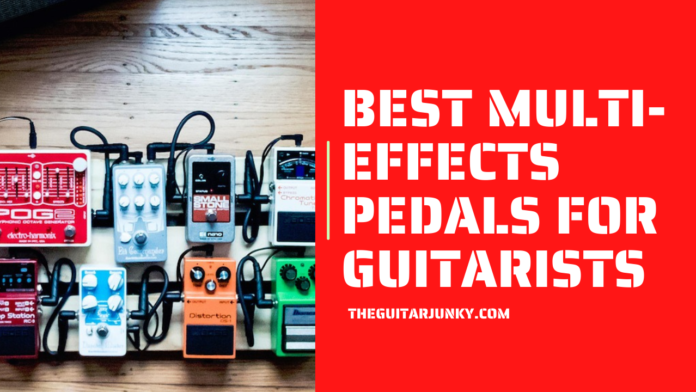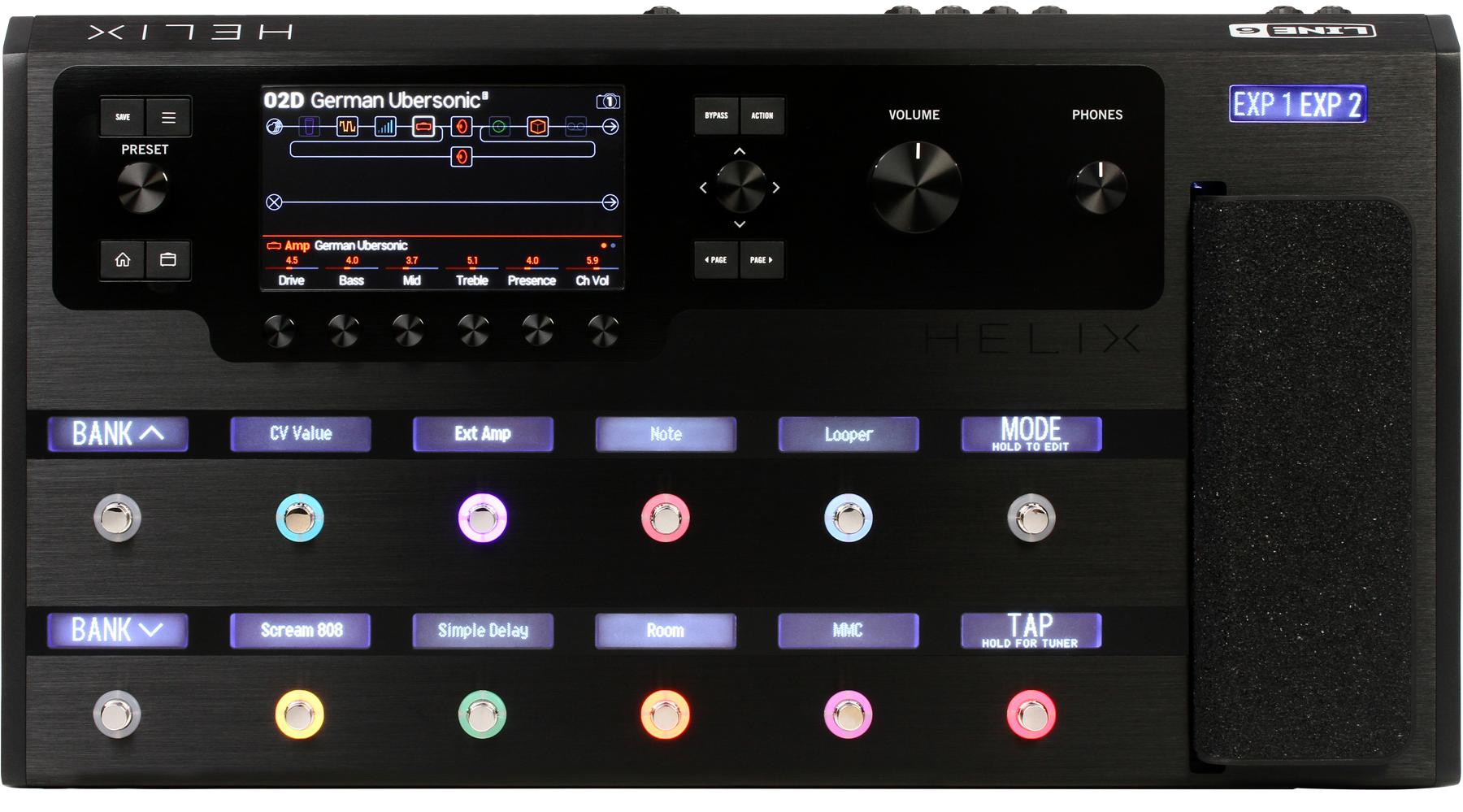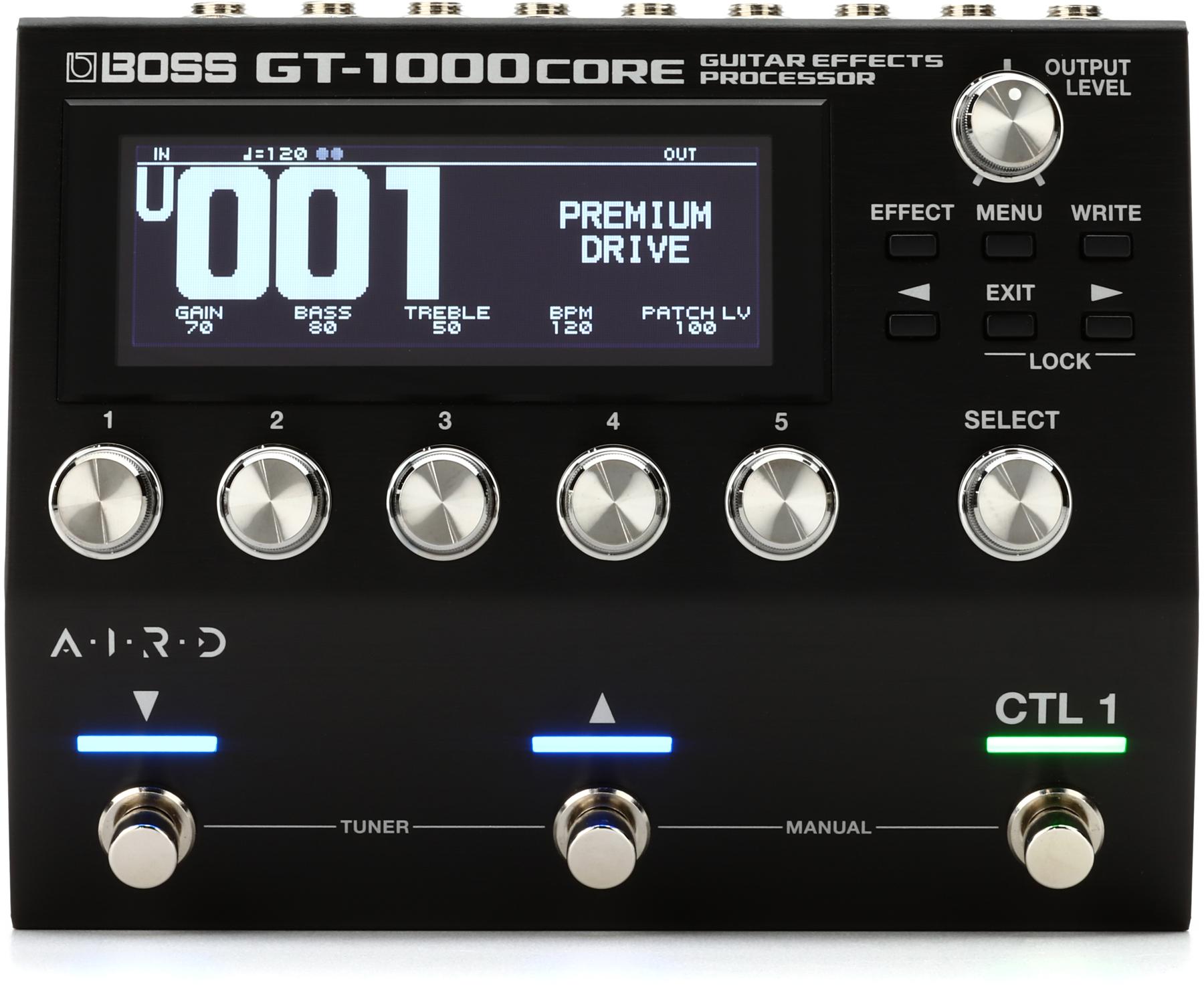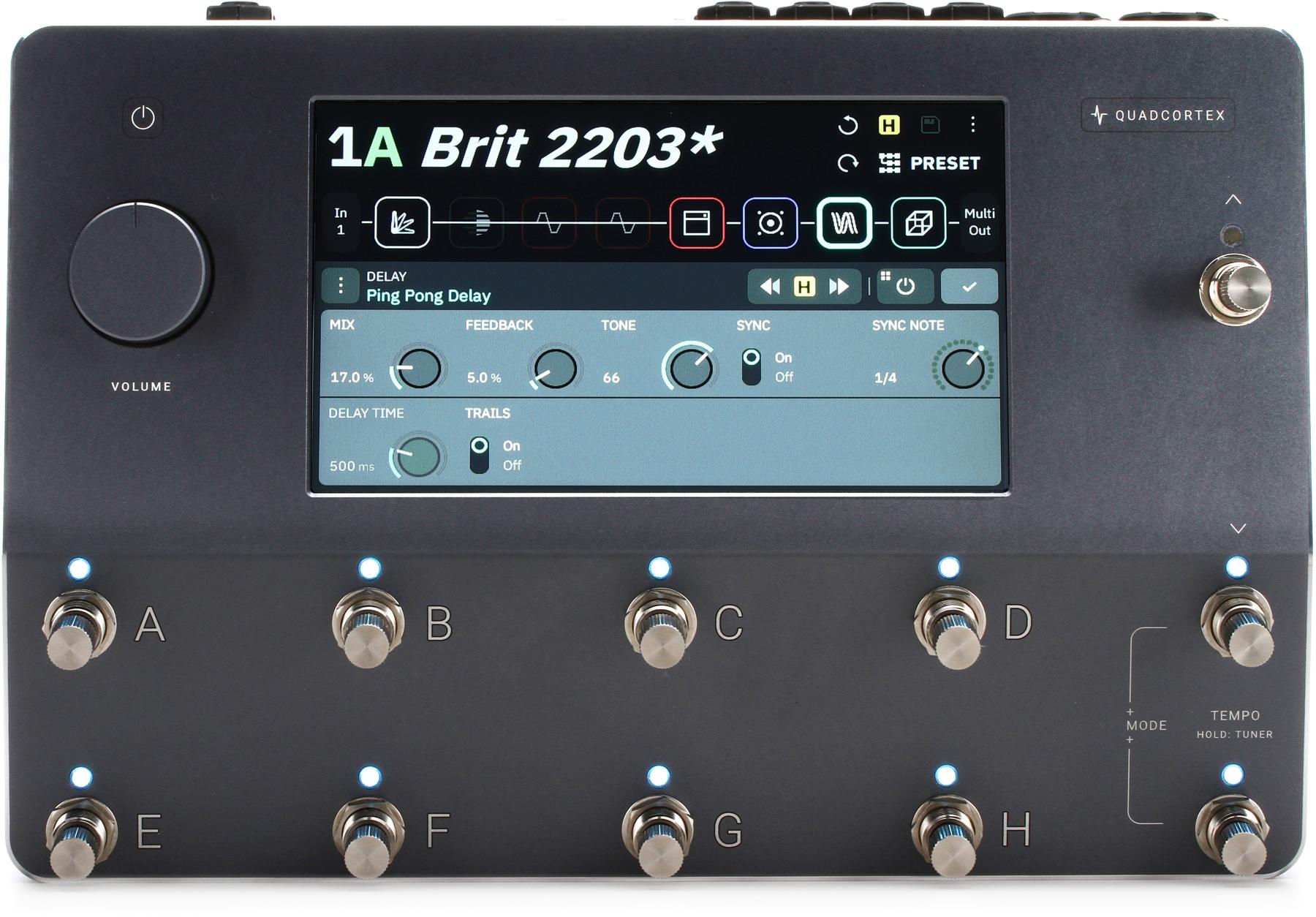Guitarists often doubt whether they need effects pedals or not, but a lot of the professionals know that pedals don’t instantly make you play better, but help you and your guitar sound better to a lot of people.
Being a guitarist for most of my life, I’ve found that effects pedals and pedalboards can mostly be replaced with innovative multi-effects pedals that integrate a lot of effects in one package.
For me, the best multi-effects pedal is the BOSS GT-1000, given its high-quality build, recording and editing capabilities, and multi-purpose engineering, allowing it to stand out among many other multi-effects pedals!
Though I understand that the perfect multi-effects pedal for me is not all that great for others, which is why I’ve made a list of what I deemed to be worthy of being the top 10 multi-effects pedals I’ve ever used!
In this article, I will be reviewing the top 10 best multi-effects pedals, as well as their pros and cons to help buyers like you choose which one would work best for your specific use.
To add to that, there will also be a buying guide to help you weed out the unnecessary info when it comes to buying a multi-effects pedal, so read on to explore the vast market of multi-effects pedals!
Contents
The Best Multi-Effects Pedals for Guitarists
- Boss GT – 1000 – Best Overall Multi-effects Pedal
- Line 6 Helix – Best Tour-Grade Multi-effects Pedal
- Neural DSP Quad Cortex – Best for Converting to Digital
- Line 6 Helix LT – Best Compact Multi-effects Processor
- Kemper Profiler Stage – Best Multi-Effects Profiler
- Boss ME-80 – Best Simplistic Multi-Effects Pedal
- Zoom MS-50G MultiStomp – Best Portable Multi-Effects Pedal
- Eventide H9 Max – Best Complement for Pedalboard Setups
- Headrush Gigboard Guitar FX – Best for Beginners
- Tech 21 Fly Rig 5 v2 – Best Analog Amp Emulator
Also Great | Editor's Choice | Budget Pick |
Boss GT – 1000
The BOSS GT-1000 earns the title of the best overall multi-effects pedal because, despite its very simplistic design, it produces great sound with its great processing power and recording and editing capabilities.
The GT-1000 houses a 32-AD/DA and 96kHz internal processing power, Roland Tube Logic and Augmented Impulse Response Dynamics (AIRD) technologies, as well as BOSS’s patented multi-dimensional processing, allowing it to perfectly reproduce and even heighten the sound of your gear.
The BOSS GT-1000 can also be easily connected to a computer through its USB ports, which then allows you to use any software you like to both edit and record your pieces, adding only to the multiple effects already present on the board.
BOSS also claims that their GT-1000 is not made only for guitar players, as bass players can easily integrate the multi-effects pedal into their gear, making it one of the most flexible and multi-functional multi-effects pedals in the market.
Because of its great processing power and renowned technology, it can be quite challenging to learn to use the GT-1000 to its maximum potential, but with enough patience and time, you can easily use the multi-effects pedal to produce and edit the best sound you can!
Pros
- Powerful processing power
- Integrated Roland and AIRD technology
- Easily connects to computers for editing and recording
- Also good for bass players
Cons
- Challenging to learn how to use
Line 6 Helix
The Line 6 Helix is one of the brand’s most ambitious and successful high-tech multi-effects pedals, in an effort to bring themselves back to the forefront of the modeling revolution.
At the core of the Helix is the best Line 6 dual modeling engine, the DSP HX, which has been engineered to reproduce every little sound detail that goes into your amplifier, so there is virtually no loss that can ruin the quality of your playing.
Also Read: Kemper vs Helix Profiling Amp – Which is Better and Why?
Line 6 has also designed the Helix to be as user-friendly as possible, allowing customers like you to easily adapt and learn to use their machine to its maximum potential without having to go through different manuals and tutorials that can delay you from fully enjoying the Helix.
A lot of multi-effects pedals seem to be so futuristic that they don’t seem like pedals, but Line 6 makes the Helix look and feel like a pedalboard with its footswitches, as you can easily activate your effects by tapping on the buttons with just your toes or feet.
However, in making things too simple, the Helix does sacrifice a perfect design since there is a good chance that you’ll face a lot of programming and sound bugs, which shouldn’t be a problem if you don’t rely on the Helix alone to edit your sound just how you like it.
Pros
- Cutting edge dual modeling engine
- Easy to set up and use
- Footswitches make it feel like a pedalboard
- Easily integrates with old setups
Cons
- Some programming and sound bugs
Neural DSP Quad Cortex
The Neural DSP Quad Cortex is the best multi-effects modeler not only because of its Neural Capture technology, but also the 2GHz Quad-Core processor and durable build, making it one of the most heavy-duty smart multi-effects pedals in the market.
The Neural Capture technology allows you easily “replicate” your analog and digital effects pedals, by connecting them to the modeler and having it study and replicate everything there is about the pedal, from interactions the amp, cable, pedal, and player, to the sag, saturation, breakup, and compression.
This feat is also easily achieved with the SHARC DSP processor, with a whopping 2GHz processing power that allows the chips to smartly take care of complex signal chains, so conversions between different tech eventually become imperceptible, producing seamless sound in just seconds.
The body of the Neural DSP Quad Cortex is made of bulletproof aluminum construction, allowing it to withstand all the beatings of bringing your gear on a tour, giving you so much time to use the multi-effects pedal.
However, the amp models on the Neural DSP Quad Cortex are not as great as other multi-effects pedals, which can pose a problem to those who are very specific about every detail of their playstyle.
Pros
- 2GHz processing power
- Neural Capture tech allows replication of effects pedals
- Bulletproof aluminum body makes it extremely durable
- Built-in Wi-Fi module allows for wireless access
Cons
- Amp models are not that impressive
Line 6 Helix LT
The Helix LT is – as you may have already guessed – quite similar to the original Helix, but comes in a smaller and more compact design with very little changes to the original Helix.
The core of the Helix LT is still the Line 6 dual DSP HX modeling engine, packing the Helix LT with a great capability to easily replicate every single detail that goes into your amplifier.
The Helix LT is made for those who think that the original Helix is great, but that it should be smaller, as the LT comes with the same power the original has, though with less stomp switches, less sends and returns in the effects loop, and less inputs than the original.
Despite all the lessened features on the Helix LT, it still is great for players who need a great multi-effects pedal that doesn’t take up much space, given that it still is a very capable multi-effects processor despite its size.
However, you do have to remember that bigger is better, so the Helix LT doesn’t produce as great a sound as the original Helix, what with Line 6 packing only the necessary features in such a small body, but it is a great addition to the gear you already have as it can complement other effects pretty well.
Pros
- Packed with Line 6 Dual DSP HX
- Fast and easy programming
- Easy to learn its full features
- Feels just like effects pedals
Cons
- Sound is not as great as the original Helix
Kemper Profiler Stage
Real guitar veterans know that Kemper Amps is one of the dominating brands in the market, and they’ve proven it with their Profiler Stage, one of the most advanced and capable profilers in the market.
Kemper has ingeniously preloaded the Profiler Stage with hundreds of Rigs that have been filtered and recorded to be the best, allowing you to easily play the multi-effects pedal with presets for different songs or presets from different bands and world-class rigs.
If the preloaded rigs are not your style, then you can easily search and audition sounds from real amps and stomps from the Rig Exchange, a program by Kemper that allows different guitarists from all over the world to flaunt and share their rigs to others.
The Profiler Stage comes with three operating modes, two of which allow you to flexibly play in any scenario, and another that allows you to easily select your own collection of presets.
With all the constant updates to the Profiler Stage software, Kemper does sacrifice a constant flawless performance, as there can be bugs that cause the multi-effects pedal to have power issues, which isn’t much of a problem if you constantly check it before playing on stage.
Pros
- Hundreds of preloaded rigs
- Ability to load your own rig
- Three operation modes
- Digital and analog I/O
Cons
- Power issues after updates
Boss ME-80
At first glance, the BOSS ME-80 doesn’t seem like much, seeing that it lacks a LCD screen and footswitches unlike most multi-effects pedals, but you’ll be surprised to know that the ME-80 also holds an entire library of BOSS effects!
The ME-80 has 23 different distortions from the BOSS library, as well as 11 modulation effects, giving you a wide range of effects in a single, simple-looking unit that doesn’t seem to look like much.
Additionally, the guitar preamp of the ME-80 has the same COSM technology in the BOSS GT-1000, which says a lot since it comes from the best overall multi-effects pedal.
Because of the simple design the ME-80 comes in, learning to use the multi-effects pedal is not a problem at all, letting you use it to its full potential in even less than a day!
However, you may find that the sound on the BOSS ME-80 is not as warm or “organic” as analog effects, but that is the price you have to pay when you know you’re getting a multi-effects pedal, since most – if not all – of them are completely digital to make things easier for a lot of players.
Pros
- Contains tons of effects from the BOSS library
- Same COSM tech as GT-1000
- Easy to use
- USB interface allows further editing of sounds
Cons
- Often sounds too digital
Zoom MS-50G MultiStomp
Compared to the BOSS ME-80, the Zoom MS-50G MultiStomp does a better job at not looking like much, especially since it’s designed to look exactly like a simple stompbox, but you’ll be surprised to know that this little machine actually has the capability of other multi-effects pedals!
The MS-50G MultiStomp gives you access to eight amp models ranging from vintage to modern and 47 different stomp and rack effects, allowing you to easily set up your own custom rig from all the selections available.
Surprisingly, Zoom has managed to fit in a very capable processing power in the stompbox-looking MS-50G, providing you with 30 ready-to-use presets and 50 slots for user presets, which allows you to customize your own rig from different amps and effects.
The multi-effects pedal also has a very simple interface which allows you to learn how to use it in less than a day, especially since there are only three knobs that you need to adjust in order to access the menu and edit your presets.
However, the build quality of the MS-50G MultiStomp may not feel as durable as the larger multi-effects pedals, especially since it’s extremely light and the knobs are not water-sealed, so take extra precaution when playing with this pedal so as not to ruin it early.
Pros
- Stompbox size makes it easy to carry
- Easily fits in your pedalboard design
- Great sound
- Access to eight amp models and 47 stomp and rack effects
Cons
- Not as durable as other multi-effects pedals
Eventide H9 Max
The Eventide H9 Max is another multi-effects pedal that looks exactly like a stompbox, but it is no surprise that Eventide would load it with 52 algorithms from award-winning stompboxes, making it one of the greatest sounding stompbox-looking multi-effects pedals.
The H9 Max comes with 5 I/O ports (2 input, 3 output) that allow you to easily integrate it into your pedalboard setup, especially since it does a good job as a complement to other great-sounding stompboxes or multi-effects pedals.
Since the H9 Max was designed to easily connect to your device via the H9 Control app, you can find that it is also accessible wirelessly, but you might face some problems with the app especially since it still needs some improvements, which isn’t much of a problem if you’re fine with accessing the pedal directly.
Pros
- Wireless access with H9 Control app
- Easily integrates into your pedalboard setup
- 52 algorithms from award-winning stompboxes
- 5 I/O ports
Cons
- H9 Control app needs improvements
Headrush Gigboard Guitar FX
The Headrush Gigboard Guitar FX is another of the smaller multi-effects processors that is highly capable, a great addition to your setup, and easy to use.
The Gigboard has a 7” touchscreen that gives you access to many different models and their settings, letting you edit and select them in just a few taps.
This multi-effects processor also has a quad-core DSP system that allows each and every model you select to pick up every little detail of the sound that goes into the pedal, giving you uninterrupted sound of good quality.
However, you shouldn’t expect the Gigboard to give as good a sound as a real amplifier, as it can sound very digital, which makes this good for beginners who want to explore the different multi-effects pedals in the market.
Pros
- Quad-Core DSP processor
- Easy accessibility with the touchscreen
- Easily integrates into your setup
- Great for beginners
Cons
- Does not sound as good as real amplifiers
Tech 21 Fly Rig 5 v2
The Tech 21 Fly Rig 5 V2 is one of the most advanced yet simple looking multi-effects pedals in the market, especially with its integrated technology that allows it to produce great sounds.
The SansAmp technology allows the Fly Rig 5 V2 to have an all-analog amp emulation, which basically means you won’t have to worry about your amp modeling, unlike other multi-effects pedals that sound too digital.
However, the amp emulator isn’t exactly perfect, as the sound doesn’t trail off like it usually would with real amplifiers, but rather instantly cuts off, which to some, may be an advantage, but to others can be quite bothersome.
Pros
- SansAmp technology allows all-analog amp emulation
- Great addition to pedalboard setups
- Produces uninterrupted great sound
- Integrated with dual-voiced overdrive
Cons
- Amp doesn’t trail off, but cuts off immediately
Buying Guide
Having all kinds of multi-effects pedals with varying features can make it difficult to choose one, which is why I’ve come up with a list to help you break down the most important factors to consider when choosing a multi-effects pedal.
Presets
A lot of multi-effects pedals come with different presets, like the BOSS Me-80 having different effects from the BOSS library, so what you really need to look into is the presets that come with the multi-effects pedal of your choice to see if it works well for your play style and rig.
Accessibility
Any good machine is easy to learn and access, which is one of the major factors that you should look into when choosing a multi-effects pedal.
Choosing one that has too many features can be quite daunting to learn how to maximize, so you’d be stuck with its subpar potential if you don’t dedicate the time to unlock it to its full potential.
I/O Ports
The availability of different I/O ports also gives you the flexibility to add or set up the multi-effects pedal to your liking, which is very important if you like to be specific with the kind of setup you have.
FAQs
Are stompbox-sized multi-effects pedals worth it?
If your rig is already almost complete and only needs a little bit more tweaking, then yes, stompbox-sized multi-effects pedals are totally worth it.
However, if your rig needs more work and better sound, then you should go for the larger stompboxes that allow you to select from a variety of models while still producing great sound.
Can I use these multi-effects pedals all by themselves?
Multi-effects pedals are nowhere near as perfect as real stompboxes and amplifiers, which is why I recommend using them with different stompboxes and amps in a full rig to help you get that good quality sound you’ve been looking for.
Editor’s Pick
There are so many multi-effects pedals in the market, but BOSS GT-1000 stands out as the best multi-effects pedal, especially with its highly-advanced technology and processing power.
It also has other features that allow you to edit and record on the pedal by simply connecting it to a computer to unlock its full potential, and is great for both guitarists and bassists who like to make a really good sound.













